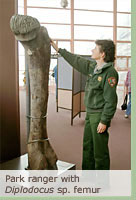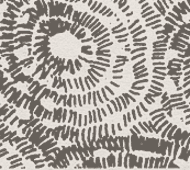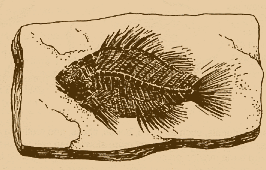





Hard materials, such as wood, bones, shells, and teeth, have a better chance of being buried and fossilized because they decay more slowly than soft tissues like leaves or skin. Sometimes, hard animal or plant parts may be preserved unchanged. More often, they are partly or totally filled in by minerals such as silica from surrounding rocks. The minerals are probably carried into the fossil by water seeping through the rock. However, scientists are still not sure how this happens.
The bones found in Dinosaur National Monument's Douglass Quarry have been mineralized with silica. In a living animal, bone consists of a hard framework laced with cells, blood vessels, marrow, and other soft materials. The Douglass Quarry bones still have their original hard framework. The soft parts have been replaced by minerals.
Mineralization makes fossils much harder and heavier than living bone. Nevertheless, the bone structure is still visible when thin slices are viewed under a microscope.
